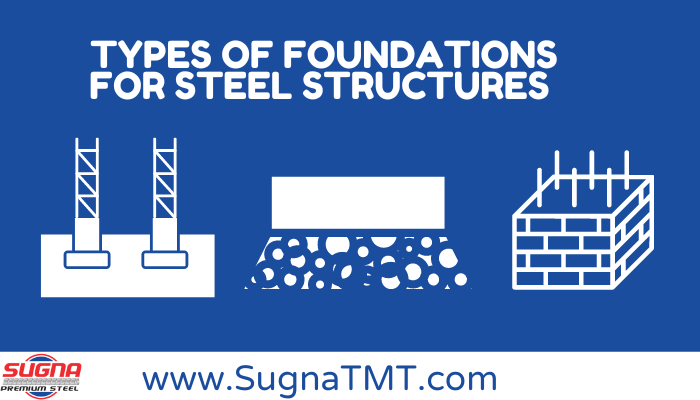Foundations are the backbone of any structure, providing the necessary support to transfer the load of the building to the ground. For steel structures, which are known for their strength, durability, and versatility, choosing the right type of foundation is crucial to ensure stability and longevity. The foundation must be designed to support the weight of the steel framework, resist environmental forces, and accommodate soil conditions. In this blog post, we will explore the different types of foundations commonly used in steel structures, along with their applications and advantages.

1. Shallow Foundations
Shallow foundations, also known as spread footings or open footings, are the most common type of foundation used in construction. These foundations are placed close to the ground surface and are typically used for structures with relatively light loads or in areas where the soil has adequate bearing capacity.
Types of Shallow Foundations:
- Isolated Footing
Isolated footings are individual footings that support single columns. They are typically square or rectangular and are used when columns are spaced far apart and the load on each column is relatively low. This type of foundation is common in steel structures where the load is evenly distributed across the building. - Combined Footing
Combined footings support two or more columns that are close to each other and share a common footing. They are used when isolated footings would overlap or when a column is too close to the property line, requiring the footing to extend in only one direction. Combined footings help distribute the load evenly across the foundation. - Strip Footing
Strip footings are continuous footings that run along the length of a load-bearing wall or a row of columns. They are commonly used in steel structures with walls or closely spaced columns. Strip footings distribute the load over a larger area, making them suitable for structures with long walls or multiple columns. - Raft or Mat Foundation
Raft foundations, also known as mat foundations, cover the entire footprint of the building. They are used when the soil bearing capacity is low, and a shallow foundation alone cannot support the load. Raft foundations distribute the load over a large area, reducing the pressure on the soil. This type of foundation is ideal for steel structures with heavy loads or in areas with soft or unstable soil.
2. Deep Foundations
Deep foundations are used when the soil near the surface is not strong enough to support the load of the structure. These foundations transfer the load to deeper, more stable layers of soil or rock. Deep foundations are commonly used in steel structures with heavy loads or in areas with poor soil conditions.
Types of Deep Foundations:
- Pile Foundation
Pile foundations consist of long, slender columns (piles) that are driven deep into the ground to reach a stable soil or rock layer. Piles can be made of concrete, steel, or timber and are used in groups to support the structure. Pile foundations are ideal for steel structures in areas with loose, compressible, or waterlogged soils, where shallow foundations would not provide sufficient support. - Drilled Shaft or Caisson Foundation
Drilled shafts, also known as caissons, are large-diameter concrete cylinders that are poured into drilled holes in the ground. Unlike piles, which are driven into the ground, drilled shafts are constructed by excavating a hole and then filling it with concrete. Drilled shafts are used in steel structures with heavy, concentrated loads, such as bridges, towers, and high-rise buildings. They provide excellent load-bearing capacity and are suitable for both end-bearing and friction-bearing applications. - Pier Foundation
Pier foundations are similar to pile foundations but are typically shorter and larger in diameter. Piers are constructed by drilling or digging holes in the ground and then filling them with concrete. They are used in steel structures where the load is concentrated in a specific area, such as under columns or heavy machinery. Pier foundations are suitable for moderate to deep depths and provide excellent stability in a variety of soil conditions.
3. Hybrid Foundations
Hybrid foundations combine elements of both shallow and deep foundations to provide additional stability and load-bearing capacity. They are used in complex steel structures where different parts of the building require different types of support.
Examples of Hybrid Foundations:
- Pile-Raft Foundation
A pile-raft foundation combines a raft foundation with piles. The raft distributes the load over a large area, while the piles provide additional support by transferring the load to deeper soil layers. This type of foundation is used in steel structures with heavy loads or in areas with varying soil conditions, where a raft foundation alone would not provide sufficient support. - Floating Foundation
Floating foundations are designed to “float” on the soil, distributing the load evenly to prevent excessive settlement. They are used in areas with soft or compressible soils where deep foundations are not feasible. Floating foundations often involve a combination of shallow and deep foundation techniques to achieve stability and minimize settlement.
Conclusion
Choosing the right type of foundation is crucial for the success and longevity of any steel structure. The choice depends on various factors, including the load of the structure, soil conditions, and environmental factors. Whether you opt for a shallow foundation, a deep foundation, or a hybrid approach, it’s essential to ensure that the foundation is designed to provide the necessary support and stability.
Steel structures are known for their strength and versatility, but they can only perform optimally if they are built on a solid foundation. By understanding the different types of foundations available and their applications, engineers and builders can ensure that their steel structures stand the test of time, providing safety, durability, and value for years to come.

